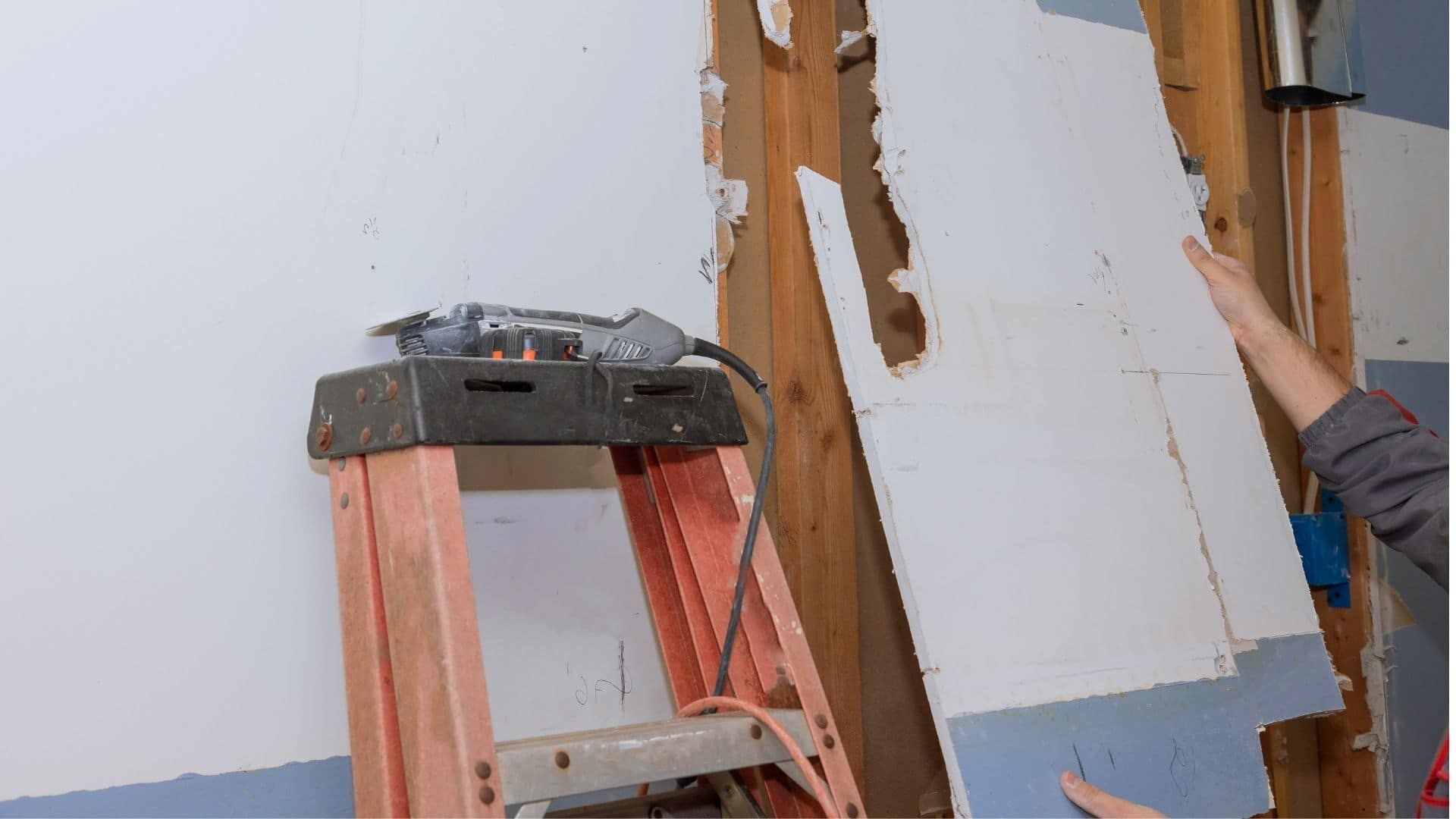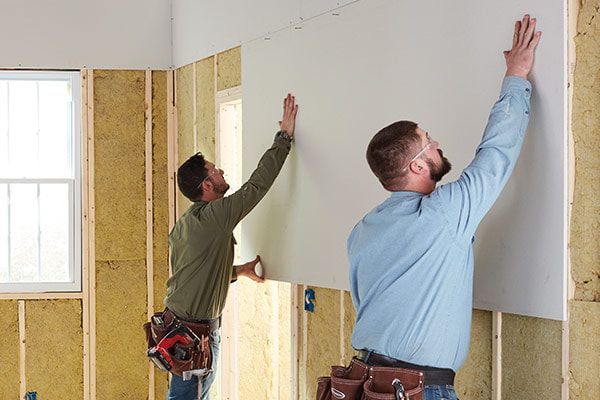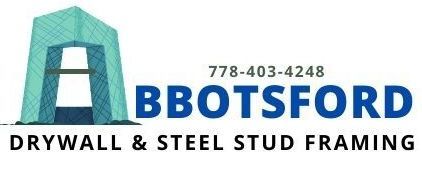Abbotsford Drywall and Steel Stud Framing
Complete Guide to Drywall Repair:
Tips and Techniques for Fixing Damaged Walls
Drywall repair refers to fixing damaged or compromised sections of drywall, a common material used for ceilings and walls in residential and commercial buildings. Drywall damage can occur for various reasons, such as accidental holes, cracks, water damage, impact, or building settling.
Drywall repair aims to restore both the strength and appearance of damaged areas. The process involves evaluating the damage, cleaning the affected area, applying patching material or joint compound to fill holes or cracks, and sanding for a seamless finish. In more extensive cases, entire sections of drywall may need to be replaced.

Drywall Repair Is Necessary For Several Reasons:
- Damage
Drywall can get damaged for various reasons, such as accidental impacts, water leaks, or wear and tear. Repairing the damaged areas helps restore the structural integrity and aesthetics of the wall.
- Maintenance
Regular maintenance is essential to keep your walls in good condition. If left untreated, small cracks, holes, or dents in the drywall can worsen over time. Repairing these issues early prevents further damage and reduces the need for more extensive repairs in the future.
- Aesthetics
Drywall repair improves the appearance of your walls. By fixing dents, holes, or other imperfections, you can create a smooth, uniform surface that enhances the overall look of your space. This is particularly important if you plan to paint or decorate the walls.
- Structural integrity
Damaged drywall can compromise the structural integrity of a wall. Cracks or holes may weaken the wall's stability and make it more prone to further damage or even collapse in severe cases. Repairing the drywall ensures that it remains strong and secure.
- Property value
Well-maintained walls contribute to the value of your property. Whether you plan to sell your home or simply want to maintain its market value, addressing drywall issues and ensuring a well-maintained interior is crucial.
Repairing Drywall Includes
Drywall repair techniques may vary depending on the specific type and severity of the damage. It is important to follow proper repair methods to ensure a seamless and durable result. Having the knowledge and skills for drywall repair can save you time and money and help maintain the overall aesthetics and functionality of your walls and ceilings.
Patching small holes and cracks
Small nail holes, dents, or minor cracks can be easily patched using joint compound or spackling paste. The damaged area is filled with the compound, smoothed out, and sanded to achieve a seamless finish.
Repairing larger holes
Holes caused by doorknobs, furniture, or accidents may require a more substantial repair. This involves cutting out the damaged section, attaching a drywall patch or mesh tape, and applying joint compound to create a smooth surface.
Fixing water damage
Water leaks or moisture can lead to water stains, bulging, or sagging drywall. Repairing water-damaged drywall involves addressing the source of the water issue, removing the affected portion of the drywall, allowing it to dry, replacing it with new drywall, and applying joint compound and paint to match the surrounding area.
Dealing with corner bead damage
Corner beads, which protect the edges of drywall corners, can become damaged or loose over time. Repairing corner bead damage involves removing the damaged bead, installing a new one, and securing it with a joint compound or specialized adhesive.
Repairing textured surfaces
If the damaged area has a textured finish, such as popcorn or knockdown texture, the repair process involves recreating the texture after patching. This can be achieved using texture sprays, rollers, or specialized tools.
Drywall Repair Process
Prepare the area
Before starting the repair, ensure the damaged area is clean and free from loose debris. Use a utility knife to create clean edges around the damaged section.
Gather the right tools and materials
Ensure you have the necessary tools and materials for the repair, including joint compound, drywall tape, a putty knife, sandpaper, and a utility knife. Having everything on hand will make the process smoother.
Use the right technique
Apply joint compound using a putty knife, starting with a thin layer and gradually building it up. Feather the edges to create a smooth transition between the patch and the surrounding wall. Follow the manufacturer's instructions for drying and sanding the compound.
Secure loose or damaged drywall
If the drywall is sagging or loose, use drywall screws or adhesive to reattach it to the studs. Ensure the drywall is securely fastened before proceeding with the repair.
Take your time with sanding
Sanding is necessary to achieve a smooth and seamless finish. Use fine sandpaper and sand it in a circular motion, gradually blending the repaired area with the rest of the wall. Wiping away any dust with a clean cloth before priming and painting.
Match texture if necessary
If the repaired area has a textured finish, match the texture as closely as possible. This can be done using texture sprays and rollers or specialized techniques like stippling or sponge painting.
Prime and paint
After the repair is complete and the joint compound is dry, apply a coat of primer to seal the repaired area. If the primer is dry, you can paint over it to match the colour of the surrounding wall.
Common Materials Used For Drywall Repair
Using the right materials is essential for drywall repair to ensure a seamless and durable finish. Here are some of the best materials commonly used for drywall repair:
Joint Compound
A joint compound is a key component in repairing drywall. It is used to fill gaps, cover seams, and smooth out the surface. Joint compound comes in different types, such as lightweight and setting compound, each with its own drying time and workability.
Drywall Tape
Drywall tape is applied over the joints to reinforce them and prevent cracking. The most common types of drywall tape are paper tape and self-adhesive mesh tape. Paper tape is more durable and recommended for larger repairs, while mesh tape is easier to work with and suitable for smaller repairs.
Drywall Screws
If the drywall needs to be secured to the studs or framing, drywall screws are essential. These screws have coarse threads and a sharp point to penetrate the drywall and provide a secure hold.
Drywall Patch
A pre-made drywall patch can be used for small holes or damaged areas. These self-adhesive patches come in various shapes and sizes, making it easy to cover and blend the damaged area with the surrounding wall.
Sandpaper
After applying joint compound, sanding is necessary to achieve a smooth and even surface. Sandpaper with medium to fine grit is typically used for this purpose. It helps to feather out the edges of the repaired area and blend it seamlessly with the rest of the wall.
Primer and Paint
Once the repair is complete and the joint compound is dry and sanded, primer and paint are applied. Primer helps to seal the repaired area, ensuring good paint adhesion and a consistent finish. Choose a paint that matches the existing wall colour or plan to repaint the entire wall for a uniform look.

Preventing Your Drywalls From Getting Damaged
To minimize the need for drywall repairs, you can take several preventive measures. It's important to prevent excessive moisture, as water can cause the drywall to warp, crack, or develop mould. This includes fixing plumbing issues promptly, properly sealing windows and doors, and ensuring proper ventilation in moisture-prone areas like bathrooms and kitchens.
Handle your drywall with care to avoid accidental damage. Be cautious when moving furniture, hanging items on the wall, or performing activities that could dent or puncture the drywall. Use the right tools and techniques to minimize the risk of causing damage.
During installations, follow recommended guidelines to prevent damage. Whether you're installing shelves, artwork, or TV mounts, use appropriate anchors or screws designed to support the weight without compromising the integrity of the drywall.
Protect high-traffic areas by adding chair rails, wainscoting, or other protective mouldings. These measures help shield the lower portion of the wall from scuffs and impacts. Maintain consistent humidity levels to prevent drywall from expanding or contracting.
Use a dehumidifier to regulate the humidity within the recommended range for your region. Performing a regular inspection to catch any signs of damage early. Look out for cracks, dents, or bulges, and address them promptly to prevent further deterioration.
Lastly, educate household members about proper drywall care and maintenance. Encourage everyone to handle walls gently and avoid activities that could damage the drywall.
Conclusion
Drywall repair is necessary for homeowners and professionals alike Abbotsford Drywall and Steel Stud Framing. By understanding the process and having the right materials and tools on hand, you can effectively address common issues such as holes, cracks, and damage to your drywall.
Proper techniques, such as assessing the damage, preparing the area, installing new drywall if needed, and applying joint compound and tape, will help you achieve a seamless and professional-looking repair.
Taking your time, paying attention to detail, and following safety guidelines throughout the process are important. With the knowledge and skills gained from this guide, you can confidently tackle drywall repairs, ensuring your walls' longevity and aesthetic appeal. Remember, if the damage is extensive or beyond your comfort level, seeking professional assistance for the best results is always recommended.
